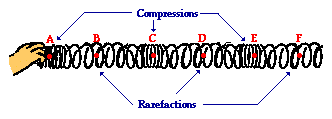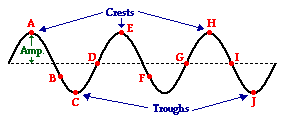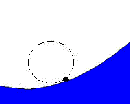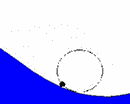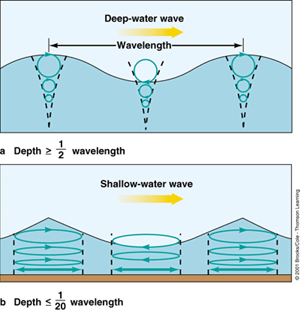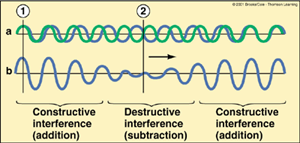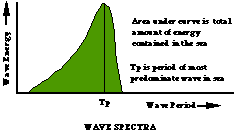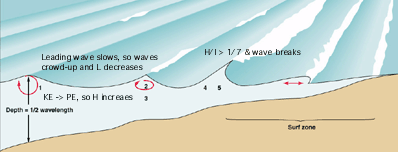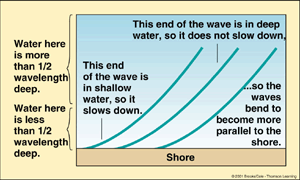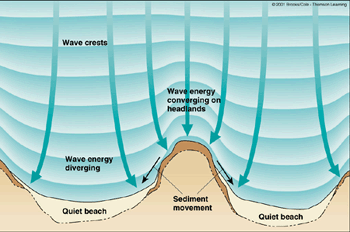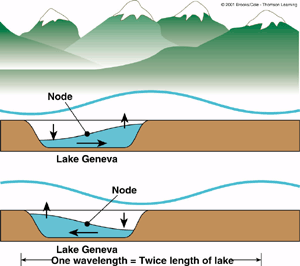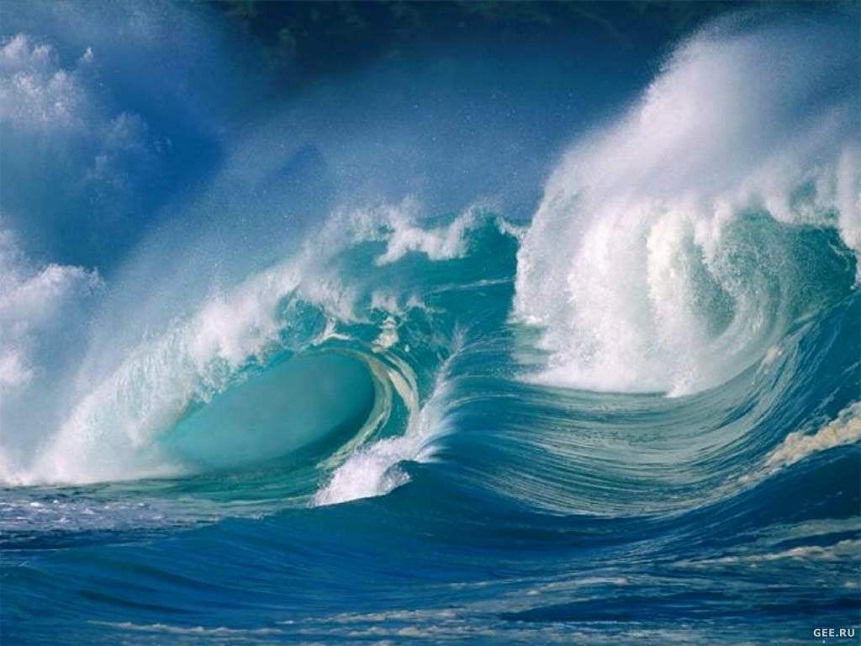 | Waves |
|
|
The images above demonstrate the orbital motion of a cork floating in the water as a wave passes from right to left. The cork''s position actually never changes other than a slight rotation. |
Water particles within a wave have different patterns of movement based on whether it is a breaking wave or not. In a normal wave, there is an orbital movement of the water particles. This is best demonstrated by a cork floating in the water. As the wave rises, the cork spins in place (pushed by the orbital motion). This is a very passive movement, whereas the lined particle movement of a breaking wave is very aggressive -- hence much more destructive |
WATER MOVEMENT |
WATER MOVEMENT |
The ideal ocean surface wave, as can be seen in Fig. 10.2 to the right, is sinusoidal (with crests and the troughs having identical shapes and the wave having one fixed wavelength) and orbital progressive, with water particles under the wave moving in orbital paths that make one complete cycle with the passage of one complete wave. On a spatial (or distance) scale (usually measured in meters), the horizontal distance between two adjacent crests (or troughs, for that matter) is defined as the wave length (L) and the vertical distance from the top of the crest to the bottom of the adjacent trough is defined as the wave height (H). On a temporal (or time) scale (usually measured in seconds), the time that it takes for two consecutive crests to pass a fixed point is defined as the wave period (T). The inverse of the period is the wave frequency (f), which is a measure of the number of times one complete wave will occur per unit time [with dimensions of cycles per second -- where 1 cycle per second is defined as 1 hertz (Hz)]. Finally, the speed with which a wave crest moves horizontally across the ocean surface is defined as wave celerity (c) or phase speed, and is usually measured in meters per second (not shown in the figure above). |
Wave energy in the ocean as a function of the wave period. Most wave energy isn typically concentrated in wind waves.However, large tsunami, rare events in the ocean, can trancmit more energy than all wind waves for a brief time.Tides are waves - their energy is concentrated at period of 12 and 24 hours |
|
|
Wind Wave Generation Over time the energy from the storm generates larger and larger waves that begin to gain some organization as they move away from the active generation area as "swell" - |
Total energy in a sea is represented by the green area under the spectral plot. This total energy is a measure of the energy of all waves of any size that make up the ''sea''; (remember the ''sea'' is made up of many component waves) |
Wave Fetch |
WAVE BREAKING IN THE SURF ZONE - http://www4.ncsu.edu/eos/users/c/ceknowle/public/chapter10/part3.html |
REFRACTION - Waves also may bend as they shoal (because c a d) if they approach the beach at an angle. If you have ever flown along a coastal region of the ocean in an airplane you may have noticed a series of nearly parallel swell crestlines (a "wave train") moving at an angle toward a straight coastline. At some distance away from the coast the crestlines may approach at an angle of more than 45 degrees, but as they get closer to shore they appear to bend so that the crestlines are more parallel with the coastline by the time they reach the surf zone (as shown on the right in Fig. 10.20a). They bend (refract) because the portion of a crestline that reaches shallow water first is slowed (remember that c a d), but the portion still in deeper water continues at its regular celerity. Therefore, the crestlines appear to "wheel around" until most of its length is approaching the coastline nearly head-on (i.e., nearly parallel with the line of the coast). |
Note that during this refraction into the bay, the area between two wave rays and two adjacent wave crests increases. What this means is that the wave energy per unit area is greatly decreased and will be small when the train enters the surf zone of the bay. |
STANDING WAVES AND TIDES - http://www4.ncsu.edu/eos/users/c/ceknowle/public/chapter10/part5.html |
|
TYPES OF WAVES
Waves take their time to develop; they don''t spontaneously erupt from the ocean. It takes a certain speed of wind to blow over a certain distance for a considerable length of time to create lasting waves.
There are three different types of waves that develop over time:
Ripples
Seas
Swells
Ripples appear on smooth water when the wind is light, but if the wind dies, so do the ripples. Seas are created when the wind has blown for a while at a given velocity. They tend to last much longer, even after the wind has died. Swells are waves that have moved away from their area of origin and are unrelated to the local wind conditions -- in other words, seas that have lasted long beyond the wind.
The definition of swells can be a bit confusing when you understand that waves never actually go anywhere. The water does not travel along with the waves, only along with the current -- two mutually exclusive elements of water animation. If two people stand at either end of a long rope and undulate their arms up and down in an equal rhythm, waves will develop along the length of the rope that appear to move from one end to the other. The rope fibers aren''t actually moving at all, other than up and down. This is exactly what is happening with waves. The speed, or velocity of the wave is measured by how long it would take a wave to pass a given point crest to crest -- say a line drawn on the ground beneath the rope. There is a slight movement of the water particles within a wave, but we''ll get into that in a little bit.
Waves can be further described as:
Non-Breaking
Breaking
A non-breaking wave, is a "normal" rolling wave. A breaking wave is one who''s base can no longer support it''s top and it collapses. Depending on the size, this can happen with considerable force behind it -- 5 to 10 tons per square yard. Enough force to crush the hull of a ship. When the ratio of steepness of a wave is too great, it must break. This happens when a wave runs into shallow water, or when two wave systems oppose and combine forces. The steepness ratio is expressed as the height to the length. A 1:24 is a long, shallow swell found in deep waters. A 1:14 and up is a wave that is too steep to stay together. This can also happen if the wind quickly grows strong and actually blows the top (crest) off the base of the wave. Wave characteristics also change in shallow water. Imagine if the rope that we talked about earlier was lowered to the ground so that the troughs of the waves hit the floor. This gives you some idea what happens when a wave hits shallow water, only the height and period won''t change, just the length and hence the steepness (as the length changes, so does the height to length ratio). Once the ratio gets high enough (like fractions, the closer together the numerator and denominator, the higher the fraction -- 1:1 is the highest [that would be a wave at a right angle with the length exactly as long as the height.]) the wave will break.
WIND AND WAVES
The interrelationship between the wind and the waves is so important to skippers that a completely new classification system was designed as a guideline incorporating both wind speed and the wave conditions most readily found at those speeds. This system, called the Beaufort Scale, was developed in 1805 by Admiral Sir Francis Beaufort of the British Navy. It is a guideline for what can be expected in certain conditions and a weather classification system.
All 52 Terms
Term Definition
law of gravity every particle of mass in the universe attracts every other particle of mass
wave period time it takes between successive wave crests to cross a fixed point
standing wave a wave oscillating vertically with out progressive movement
wave diffraction any bending of a wave around an obstacle that is not reflecting or refraction
wave refraction process by which part of a wave in shallow water slows down and bends and aligns itself with underwater contour
wave reflection process in which a wave has part of its energy return seaward by a reflecting surface
constructive interference type of interference wherein 2 waves come together in phase (crest to crest). Displaces more water than they would seperate
destructive interference type of interference wherein 2 waves come together out of phase (crest to trough). Displaces less water than either wave would alone
Mixed interference type of wave interference where there is a combination of constructive and destructive interference
wave frequency number of waves that pas a fixed point in a unit of time (ussually 1 second)
wave length horizontal distance between two corresponding points in successive waves.
wave height verticle distance between crest and adjoining height
trough the part of an ocean wave displaced below still water line
internal wave a wave that develops below the surface of a fluid. (density increases with depth)
swell a free ocean wave. energy generated by sea winds. travels great distance with little energy loss to be released in the surf zone
sea portion of the ocean where waves are generated by wind
surf zone the region between shoreline and line of breakers where most wave energy is released.
tsunami long period gravity wave generated by underwater earthquakes and volcanic events. seismic sea wave.
shallow water wave wave on surface of water whose wave length is at least 20x the water depth. the bottom affects the orbit of water particles. speed is determined by water depth
orbital wave wave phenomena in which energy moves along the interface between fluids of different denisty. wave form is propagated by movement of fluid particles in orbital path
wave train series of waves from the same direction
plunging breaker impressive curling breakers that form on moderately sloping beaches
spilling breaker a type of breaking wave that forms on gently sloping beaches. gradually extracts energy from the wave creating a turbulant mass of air and water
capillary wave ocean wave whose wave length = to less than 1.74 cm. dominant restoring force for such waves is surface tension
storm surge a rise above water level caused by wind and reduced atmospheric pressure during storms
transverse wave wave in which particle motion is at right angles to energy propogation
crest wave portion of an ocean wave that is displaced above still water line
resonating force a force such as surface tension or gravity that tends to rest on the ocean surface displaced by a wave to that of a still water level
wave steepness ratio of wave height to wave length. H:L if a 1:7 ratio is exceeded, the wave breaks
Tidal Bore steep fronted wave that moves up some rivers when the tide rises in the ocean basins
Sir Isaac Newton developed universal law of gravitation which helps explain tides
seiche standing wave of an enclosed or semienclosed body of water that may have periods ranging from a few minutes to a few hours depending on dimensions of basins. Wave motion continues after imitating force has ceased
ebb current seaward flowing current during a decrease in height of tide
tidal range difference in height between consecutive high and low waters. time frame of comparrison may also be a day, month or year
tidal period elapsed time between successive high and low tides
mixed tide tide having 2 high and 2 low waters per tidal day with a marked diurnal inequality. such a tide may also show alternating periods of diurnal and semidiurnal components
semidiurnal tide tide having 2 high and 2 low waters per tidal say with small inequalities between successive highs and lows
diurnal tide tide with 1 high water and 1 low water during a tidal day. tidal period: 24hrs 10mins
neap tide tides of minimal range occuring when moon is in quaderature
quarter moon 1st and 3rd moon phases occurring when moon is in quaderature about 1 week after new moon and full moon phases
spring tide tide of max range occurring every 2 weeks when moon is new or full
full moon phase that occurs when sun and moon are in opposition
new moon phase that occurs when sun and moon are in conjunction
vernal equinox passage of sun as it crosses equator from S to N hemisphere
autumnal equinox passage of sun across equator from N to S hemisphere
winter solstice instant Southern moving sun reaches tropic of cancer before changin direction and moving north back to equator
summer solstice instant when northern moving sun reaches tropic of cancer before changing direction and moving south toward equator
apogee point on orbit of moon farthest from earth
perigee point on orbit of moon nearest earth
aphelion point on orbit of earth when farthest away from sun
perihelion point on orbit of earth when nearest the sun
gravitational force force of attraction that exists between any 2 bodies in the universe that is proportional to the product of their masses and inversely proportional to distance between centers of their masses
Physics
Understanding and Utilizing the Secrets of Waves (by Jay Holben)
A Creation Shaped From Wind, Current, and Water Depth
All 52 terms
